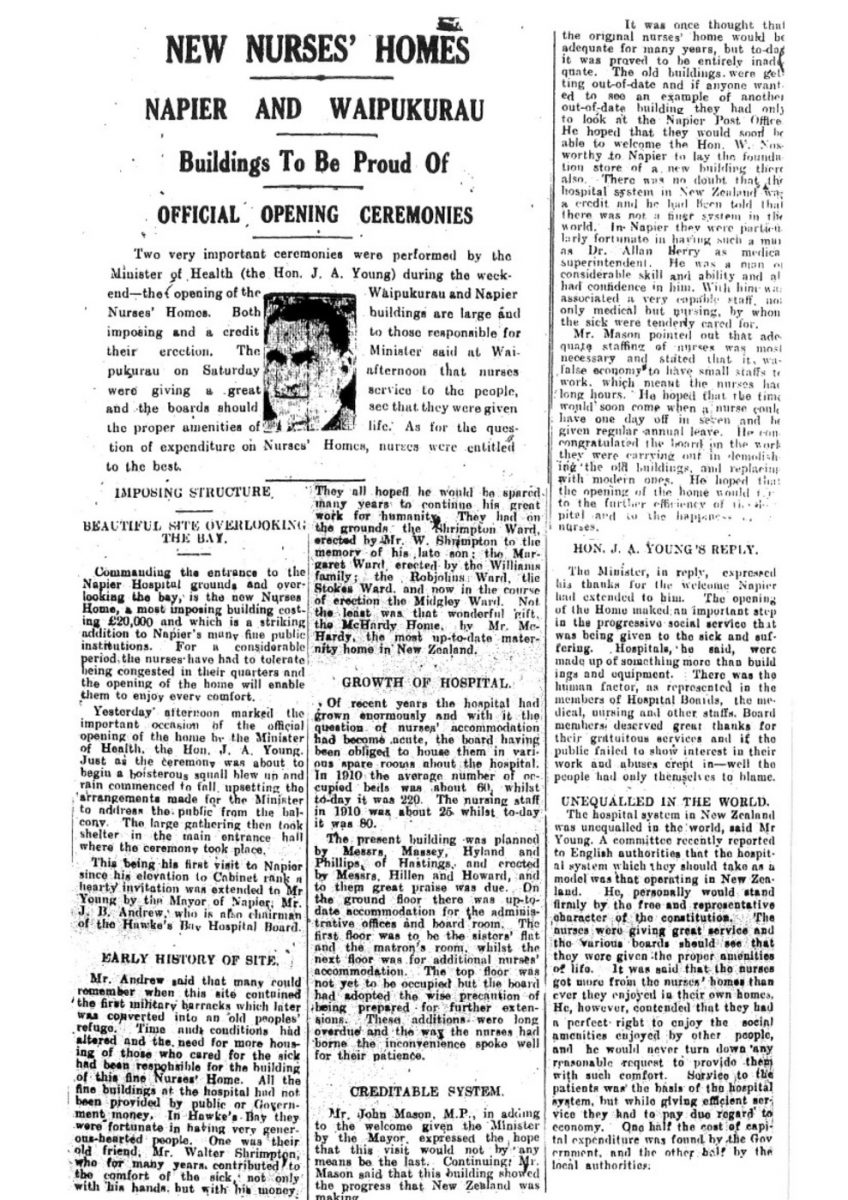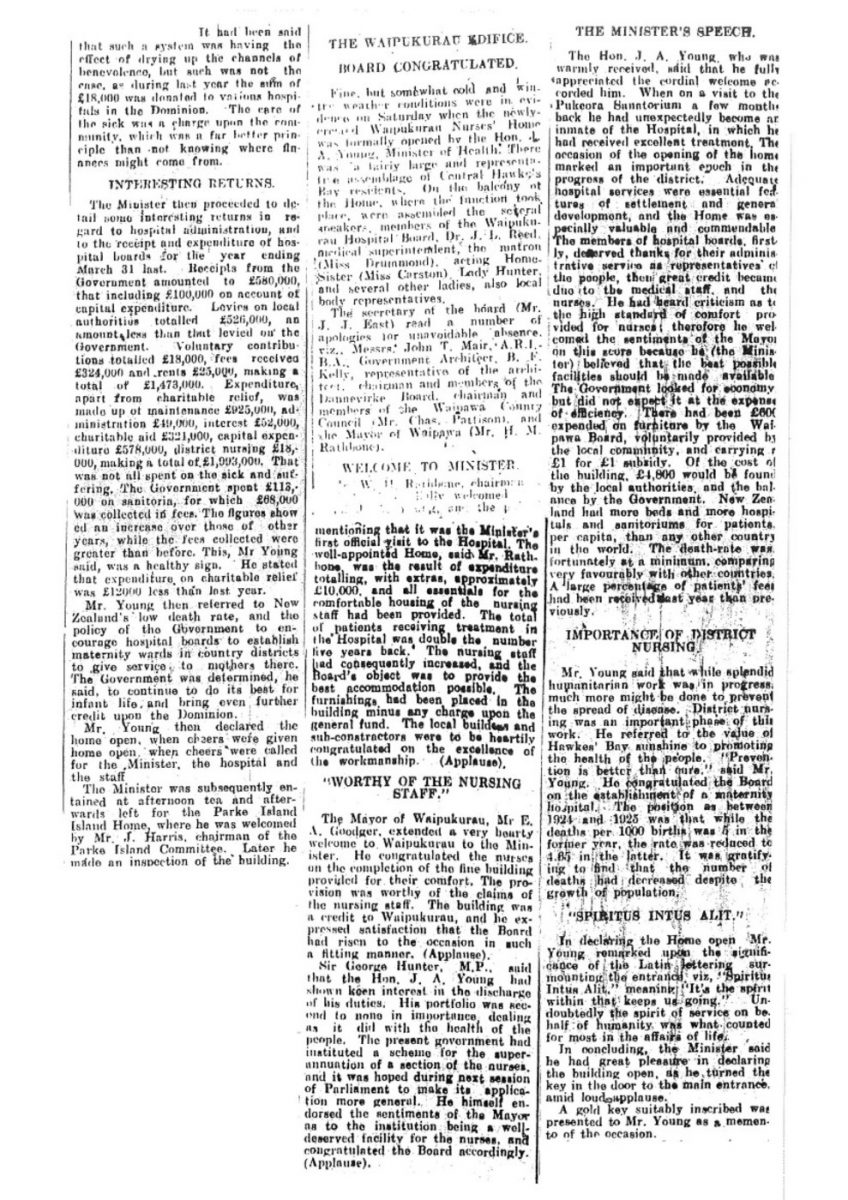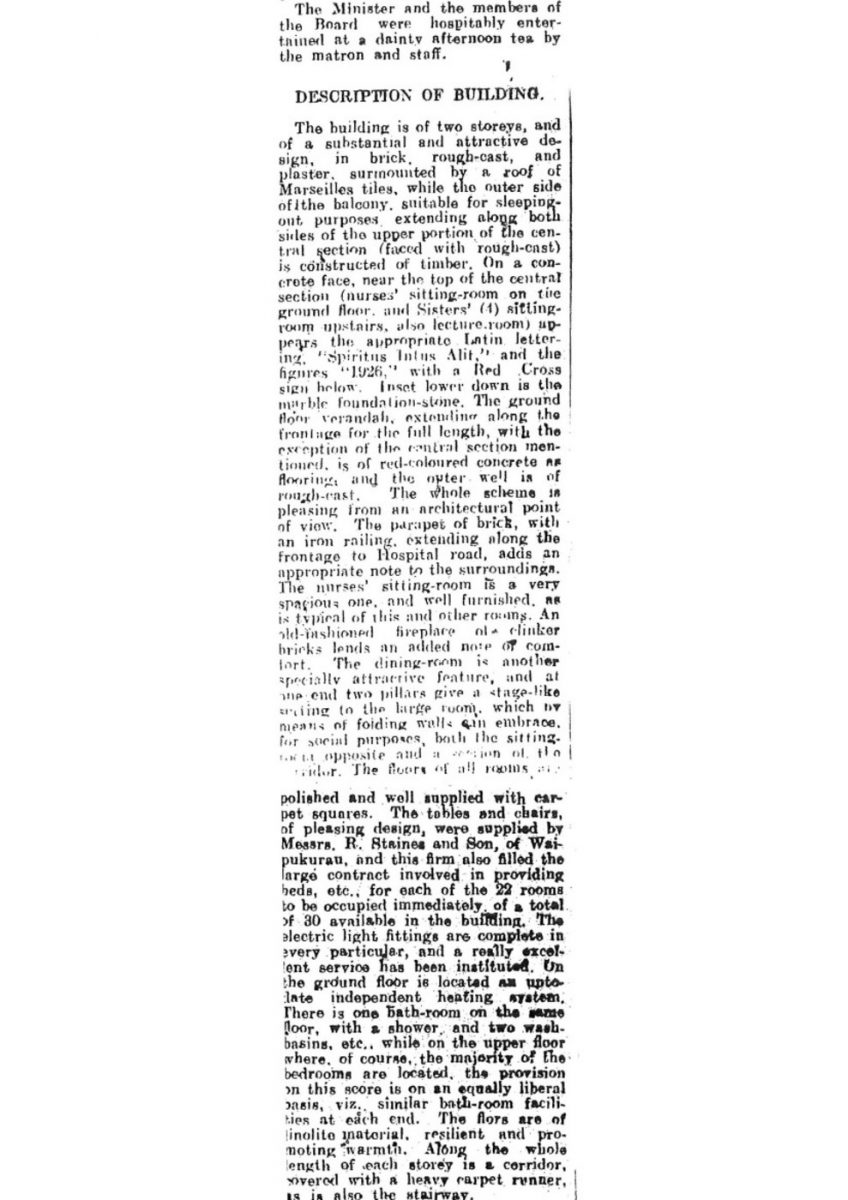It had been said that such a system was having the effect of drying up the channels of benevolence, but such was not the case, as during last year the sum of £18,000 was donated to various hospitals in the Dominion. The care of the sick was a charge upon the community, which was a far better principle than not knowing where finances might come from.
INTERESTING RETURNS.
The Minister then proceeded to detail some interesting returns in regard to hospital administration, and to the receipt and expenditure of hospital boards for the year ending March 31 last. Receipts from the Government amounted to £580,000, that included £100,000 on account of capital expenditure. Levies on local authorities totalled £526,000, an amount less that that levied on the Government. Voluntary contributions totalled £18,000, fees received £324,000 and rents £25,000, making a total of £1,473,000. Expenditure, apart from charitable relief, was made up of maintenance £925,000 administration £49,000, interest £52,000, charitable aid £321,000 capital expenditure £578,000, district nursing £18,000, making a total of £1,993,000. That was not all spent on the sick and suffering. The Government spent £113,000 on sanitoria, for which £68,000 was collected in fees. The figures showed an increase over those of other years, while the fees collected were greater than before. This, Mr Young said, was a healthy sign. He stated that expenditure on charitable relief was £12,000 less than last year.
Mr. Young then referred to New Zealand’s low death rate, and the policy of the Government to encourage hospital boards to establish maternity wards in country districts to give service to mothers there. The Government was determined, he said, to continue to do its best for infant life and bring even further credit upon the Dominion.
Mr. Young then declared the home open, when cheers were given home open, when cheers were called for the Minister, the hospital and the staff.
The Minister was subsequently entained [entertained] at after noon tea and afterwards left for the Parke Island Home, where he was welcomed by Mr. J. Harris, chairman of the Parke Island Committee. Later he made an inspection of the building.
THE WAIPUKURAU EDIFICE.
BOARD CONGRATULATED.
Fine, but somewhat cold and windy weather conditions were in evidence on Saturday when the newly opened Waipukurau Nurses’ Home was formally opened by the Hon. J.A. Young, Minister of Health. There was a fairly large and representative assemblage of Central Hawke’s Bay residents. On the balcony of the Home, where the function took place, were assembled the several speakers, members of the Waipukurau Hospital Board, Dr. J.L. Reed, medical superintendent, the matron (Miss Drummond), acting Home-Sister (Miss Carston), Lady Hunter, and several other ladies, also local body representatives.
The secretary of the board (Mr. J.J. East) read a number of apologies for unavoidable absence viz., Messrs. John T. Mair, A.R.I.B.A., Government Architecture, B.F. Kelly, representative of the architect, chairman and members of the Dannevirke Board, chairman and members of the Waipawa County Council (Mr. Chas [Charles] Pattison), and the Mayor of Waipawa (Mr. H.M. Rathbone).
WELCOME TO MINISTER.
Mr. W.H. Rathbone, chairman […] welcomed […] mentioning that it was the Minister’s first official visit to the Hospital. The well-appointed Home, said Mr. Rathbone, was the result of expenditure totalling, with extras, approximately £10,000, and all essentials for the comfortable housing of the nursing staff had been provided. The total of patients receiving treatment in the Hospital was double the number five years back. The nursing staff had consequently increased, and the Board’s object was to provide the best accommodation possible. The furnishings had been placed in the building minus any charge upon the general fund. The local builder and sub-constractors [sub-contractors] were to be heartily congratulated on the excellence of the workmanship. (Applause).
“WORTHY OF THE NURSING STAFF.”
The Mayor of Waipukurau, Mr E. A. Goodger, extended a very hearty welcome to Waipukurau to the Minister. He congratulated the nurses on the completion of the fine building provided for their comfort. The provision was worthy of the claims of the nursing staff. The building was a credit to Waipukurau and he expressed satisfaction that the Board had risen to the occasion in such a fitting manner. (Applause).
Sir George Hunter, M.P., said that the Hon. J.A. Young has shown keen interest in the discharge of his duties. His portfolio was second to none in importance, dealing as it did with the health of the people. The present government has instituted a scheme for the superannuation of a section of the nurses, and it was hoped during next session of Parliament to make its application more general. He himself endorsed the sentiments of the Mayor as to the institution being a well-deserved facility for the nurses, and congratulated the Board accordingly. (Applause).
THE MINISTER’S SPEECH.
The Hon. J.A. Young, who was warmly received, said that he fully appreciated the cordial welcome accorded him. When on a visit to the Pukeora Sanatorium [sanitorium] a few months back he had unexpectedly become an inmate of the Hospital, in which he had received excellent treatment. The occasion of the opening of the home marked an important epoch in the progress of the district. Adequate hospital services were essential features of settlement and general development, and the Home was especially valuable and commendable. The members of hospital boards, firstly, deserved thanks for their administrative service as representatives of the people, then great credit became due to the medical staff, and the nurses. He had heard criticism as to the high standard of comfort provided for nurses ; therefore he welcomed the sentiments of the Mayor on this score because he (the Minister) believed that the best possible facilities should be made available. The Government looked for economy but did not expect it at the expense of efficiency. There had been £600 expended on furniture by the Waipawa Board, voluntarily provided by the local community, and carrying a £1 for £1 subsidy. Of the cost of the building, £4,800 would be found by the local authorities, and the balance by the Government. New Zealand had more beds and more hospitals and sanitoriums for patients per capita, than any other country in the world. The death-rate was, fortunately at a minimum, comparing favourably with other countries. A large percentage of patients’ fees[?] had been received that year than previously.
IMPORTANCE OF DISTRICT NURSING.
Mr. Young said that while splendid humanitarian work was in progress, much more might be done to prevent the spread of disease. District nursing was an important phase of this work. He referred to the value of Hawkes’ Bay sunshine to promoting the health of the people. “Prevention is better than cure.” said Mr Young. He congratulated the Board on the establishment of a maternity hospital. The position as between 1924 and 1925 was that while the deaths per 1000 births was 5 [five] in the former year, the rate was reduced to 4.65 in the latter. It was gratifying to find that the number of deaths had decreased despite the growth of population.
“SPIRITUS INTUS ALIT.”
In declaring the Home open Mr. Young remarked upon the significance of the Latin lettering surmounting the entrance, viz, “Spiritus Intus Alit.,” meaning, “It’s the spirit within that keeps us going.” Undoubtedly the spirit of service on behalf of humanity was what counted for most in the affairs of life.
In concluding, the Minister said he had great pleasure in declaring the building open, as he turned the key in the door to the main entrance, amid loud applause.
A gold key suitably inscribed was presented to Mr. Young as a memento of the occasion.














Do you know something about this record?
Please note we cannot verify the accuracy of any information posted by the community.